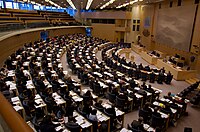| This article possibly contains original research. Please improve it by verifying the claims made and adding inline citations. Statements consisting only of original research should be removed. (October 2023) (Learn how and when to remove this message) |
| This article needs additional citations for verification. Please help improve this article by adding citations to reliable sources. Unsourced material may be challenged and removed. Find sources: "Hemicycle" – news · newspapers · books · scholar · JSTOR (April 2021) (Learn how and when to remove this message) |
 The Theatre of Dionysus, which hosted the Athenian Ecclesia, around the 4th century BCE
The Theatre of Dionysus, which hosted the Athenian Ecclesia, around the 4th century BCE
A hemicycle is a semicircular, or horseshoe-shaped, legislative debating chamber where members sit to discuss and vote on their business. Although originally of Ancient Greek roots, the term and modern design derive from French politics and practice.
Usage
The circular shape is designed to encourage consensus among political parties rather than confrontation, such as in the Palace of Westminster, where the government and opposition parties face each other on opposing sets of benches. The design is used in most European countries (and hence was adopted by the European Parliament) and the United States.
The United Kingdom, which is the originator of the Westminster system, does not use a hemicycle. However, two of the three devolved legislatures, the Scottish Parliament and Senedd (Welsh Parliament), do, while the Northern Ireland Assembly is a hybrid "horseshoe” format.
Arrangement
In the case of Australia (pictured below), the two largest parties still face each other, whereas in the Scottish Parliament's hemicycle, the largest party sits in the middle. However, some hemicycles follow a strict left–right arrangement with, for example, a left wing governing party sitting on the left and the right wing opposition on the right. In these cases election results are often portrayed in the hemicycle to show the results of left wing or right wing coalitions (reaching 50% in the centre, where centrist third parties are located) for the formation of a majority.
Variations
Some Westminster-system countries outside the UK, such as India, New Zealand and Australia, have confrontational benches, but the end segment is curved to create a partial hemicycle; while other countries, such as the People's Republic of China, have a single set of benches facing towards a stage area (which reflects the one-party system in operation there).
-
 Semicircular Siambr in the Senedd (Welsh Parliament)
Semicircular Siambr in the Senedd (Welsh Parliament)
-
 Debating chamber in the Scottish Parliament
Debating chamber in the Scottish Parliament
-
 The British House of Commons with its Westminster-style benches (old chamber shown)
The British House of Commons with its Westminster-style benches (old chamber shown)
-
 The Australian House of Representatives, arranged in a hybrid format
The Australian House of Representatives, arranged in a hybrid format
-
 The Chinese National People's Congress, with benches facing a stage
The Chinese National People's Congress, with benches facing a stage
Gallery
-
 The French National Assembly in 1877; it entrenched the left–right political spectrum of its chamber in modern politics.
The French National Assembly in 1877; it entrenched the left–right political spectrum of its chamber in modern politics.
-
 Toronto City Council chambers
Toronto City Council chambers
-
Hong Kong Legco chambers
-
 The European Parliament, seen in 2006, began operating in a hemicycle from its foundation in 1958, based on European traditions.
The European Parliament, seen in 2006, began operating in a hemicycle from its foundation in 1958, based on European traditions.
-
 The Toledo Museum of Art once contained a performance space called the Hemicycle, seen here in 1912.
The Toledo Museum of Art once contained a performance space called the Hemicycle, seen here in 1912.
-
 Parliament of Sweden
Parliament of Sweden
-
 National Assembly of Venezuela
National Assembly of Venezuela
-
 Graphical representation of the left–right spread of members in the 2009 European Parliament
Graphical representation of the left–right spread of members in the 2009 European Parliament
See also
References
External links
 Media related to Hemicycles at Wikimedia Commons
Media related to Hemicycles at Wikimedia Commons